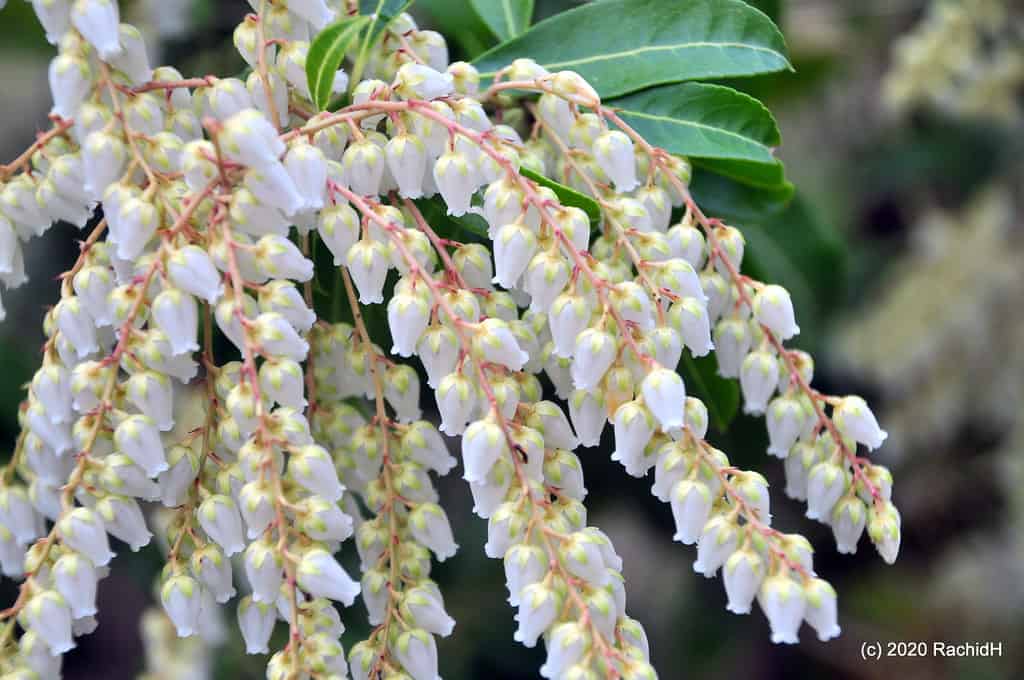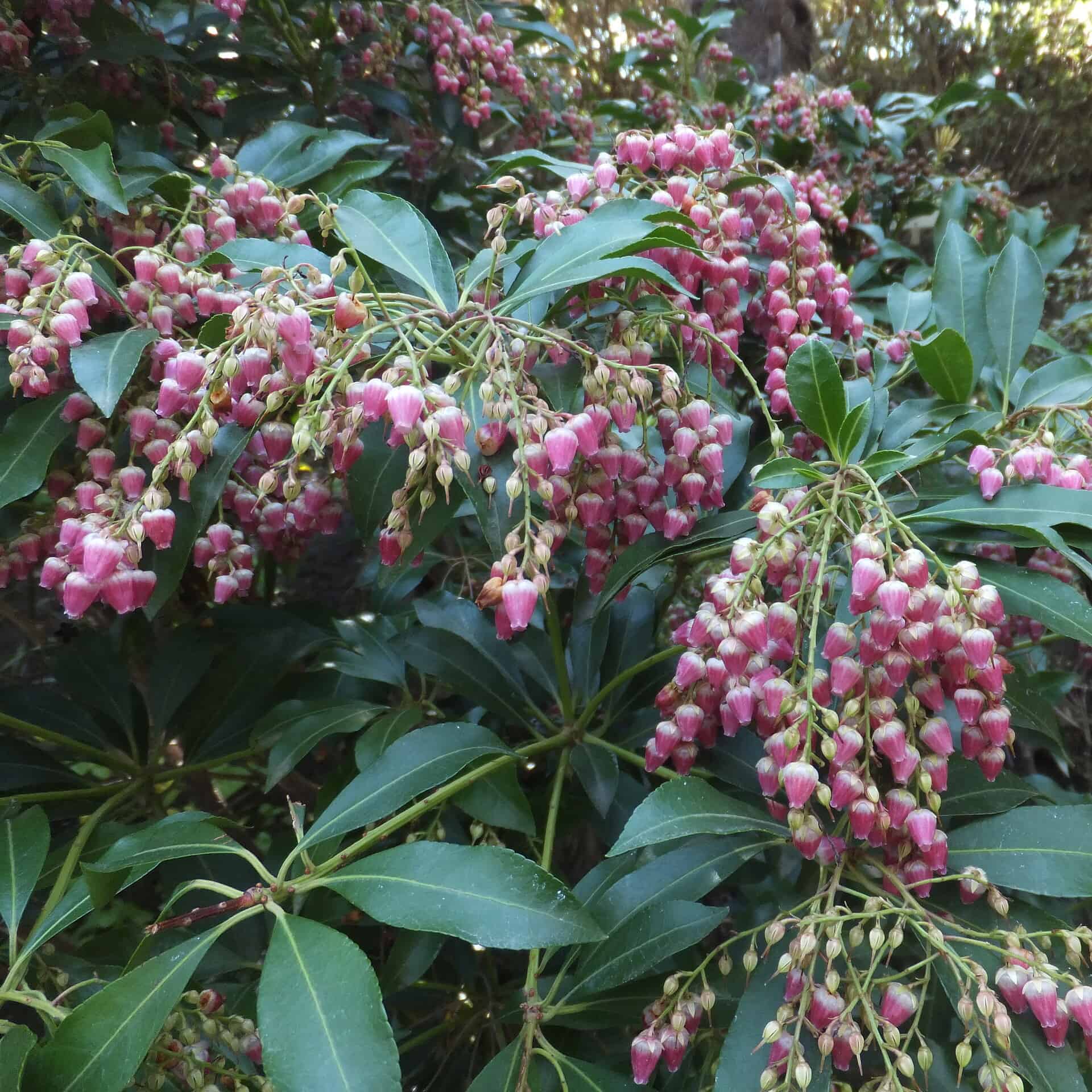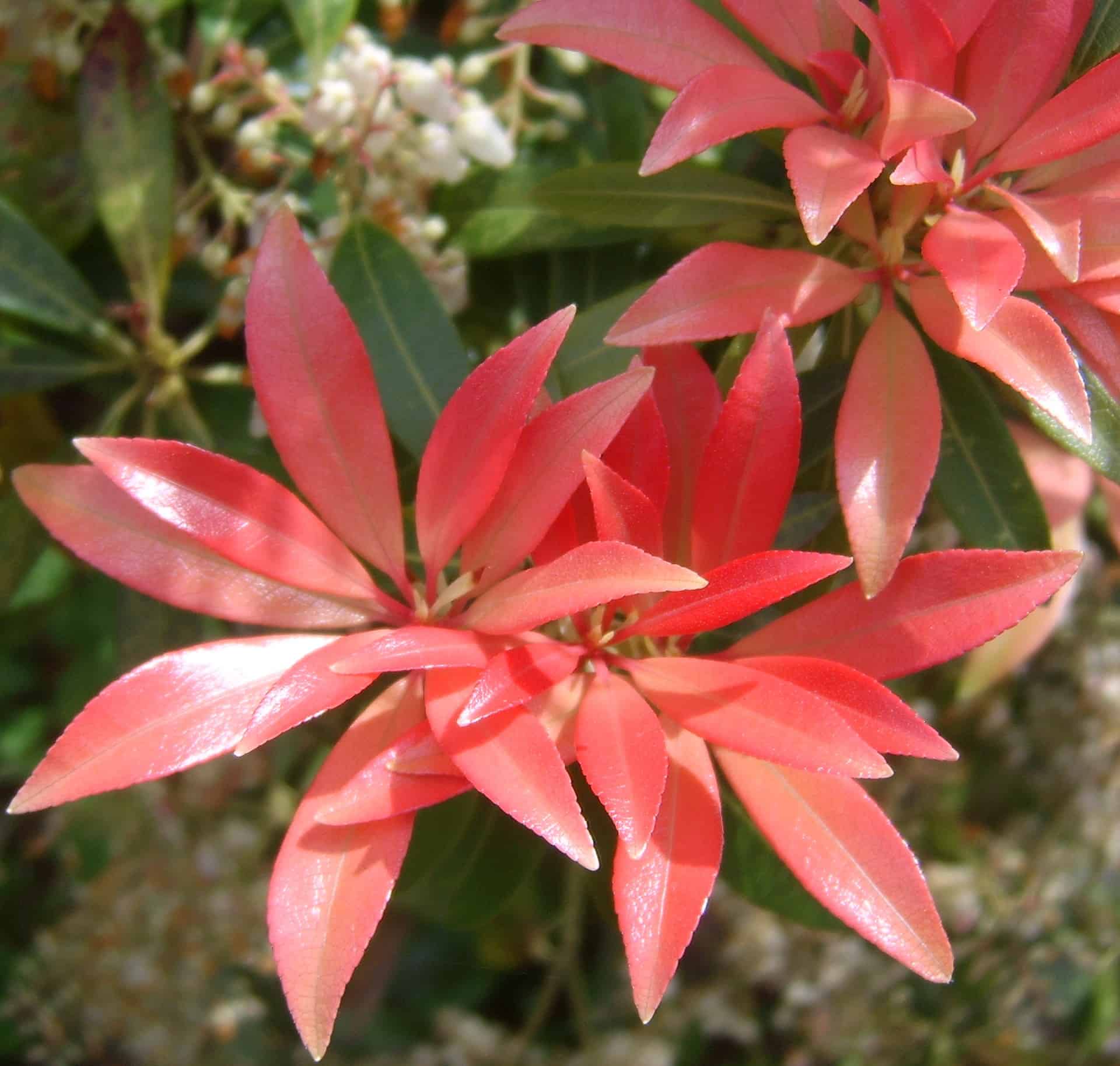No products in the cart.
For something spectacular in the garden, nothing comes close to the eye-catching Pieris japonica. The shrub is better known as the Andromeda japonica, an evergreen shrub you will not tire off.
The foliage is spectacular and changes throughout the year, while the white flowers in spring are something to see. You can use them for shrub borders, woodland gardens, or foundation plantings.
Plant Name: Pieris japonica
Other Name: Andromeda Japonica, Fetterbush, Japanese Andromeda, Japanese Pieris, Lily-of-the-Valley Shrub
Native Area: Eastern China and Japan
Plant Type: Evergreen Shrub
Growth: 12 Feet Tall to 8 Feet Wide
Fertilizer: For Acid-Loving Plants
Light Requirement: Full Sun to Partial Shade
Propagation: Cuttings
Soil Type: Well-drained Soil
Temperature: Medium Temperatures to High Humidity
Toxicity: Toxic to Humans and Pets
Watering: Average
USDA Hardiness Zones: 5 to 7
About Japanese Pieris
The Japanese Andromeda flower is native to East China and the hills of Japan, known as asebi. You usually find them planted as groupings near shrines and temples. This outdoor plant belongs to the Ericaceae family.
It is a genus of flowering plants, also known as the Heather or Heath family, including huckleberry, azaleas, blueberry, and cranberry. The Japanese Andromeda flowers look fabulous with their flower buds in white or pink in early spring.
It is a slow-growing shrub with a naturally attractive shape with new growth in bronze-red or purple, turning to different shades throughout the year. The show white flowers bloom primarily in spring and are present for up to three weeks.
When the flower buds dry, they can persist throughout winter if not removed, forming berries. It grows rosette-formed foliage with greenish-yellow twigs.
Pieris Japonica Growing Guide
 Japanese Andromeda @flickr
Japanese Andromeda @flickr
Growing Pieris is pretty simple, but it still has some fussy needs. You can find them as nursery plants in the spring or fall season. Still, as it is a slow-growing shrub, it does take time to become established.
Thus, when choosing a perfect location for your Japanese Andromeda bushes, select a spot that depends on the climate where you live. One thing is sure the fragrant pink or white flowers in a bell-shaped form and reddish bronze color are sure to be pleasing.
Eventually, the foliage changes to dark green evergreen leaves. Then in winter, you see white flower buds looking like beads on star-shaped trendils, and the bloom cycle starts again.
The Best Soil For Lily of The Valley Bush
Earlier, we mentioned that the Japanese pieris shrubs are a bit picky. Well, the picky is all about getting the proper soil preparation done. Choose well-drained and rich soil that is consistently moist.
Furthermore, the pH level needs to be 5.1 to 6.0 as it thrives in acidic soil that is consistently moist. So if it is in alkaline soil, it helps to add fertilizers made for azaleas to increase the acidity.
While adding vermiculite, perlite, coarse sand, or coco peat helps with drainage. Still, your evergreen shrub loves moist soil. It does not enjoy wet soil, leading to root rot and other fungal diseases.
The Best Light For Gorgeous Blooms in Early Spring
 Japanese Andromeda in full sun @flickr
Japanese Andromeda in full sun @flickr
Choosing the right spot for your Japanese Andromeda depends on the climate where you live. If you live in cooler regions, keep your Japanese Pieris in a spot to receive full sun for up to eight hours daily.
Planted as shrub groupings in warmer climates, choose a spot that provides partial shade and not direct sunlight all day. Your plants also need good air circulation and protection from the afternoon sun.
If you live in a warmer area, keeping it in partial shade is best to ensure your plant is protected from the afternoon sunlight.
Watering Your Pieris Japonica
The trick with your Pieris japonica is maintaining the correct moisture in the soil. It is recommended to water your Japanese Andromeda once a week to keep the soil moist down to three inches deep.
Alternatively, to help retain moisture, add a thick layer of pine needles around the base of your plant. Still, as the saying here at Plantly goes with every article we write, stick your finger in the ground to check if the soil up to three inches deep is dry or moist before watering.
This specimen plant also does not enjoy wet feet, so be careful not to overwater your indoor plant. The Japanese Andromeda is susceptible to root rot and leaf spot.
Temperature and Humidity
While the Japanese Andromeda is fussy about the potting mix to light exposure and needing good drainage, it is not picky about temperature or humidity. What it cannot tolerate are freezing weather and winds.
So, whether grown in part shade to direct sunlight in your region, protect them from winter winds. We recommend wrapping burlap around your bush to prevent leaf browning or die-back.
Fertilizing Your Evergreen Shrub
For your Pieris japonica to thrive, it needs feeding. It needs a rich potting medium to provide the nutrients needed to flourish and display those gorgeous blooms. So keep the soil consistently moist and apply an acid-loving feed like for azaleas in the growing season of early spring to early summer.

Or add some acidic organic matter like pine and prevent soggy soil in the garden.
Pruning Your Pieris Japonica
When caring for your Lily of The Valley, do light pruning to keep it happy. Also, deadhead the spent flowers regularly to prevent them from seeding. As shrub borders, it does not need much trimming and looks fabulous in its natural state.
You can remove the damaged or diseased branches if pests and diseases are present.
Potting Your Japanese Pieris
If you choose to grow your Japanese Andromeda in pots, select one the same size as the nursery pot you received it in. Also, ensure that good drainage is present. Finally, fill the container with a well-drained potting mix and tamp it down to remove air pockets.
Then water well after planting. Then when the root system outgrows, the pot poking through the drainage holes repot in a pot one size bigger. The best time to repot is in spring or late summer.
Propagating Japanese Andromeda
The Japanese Andromeda are impressive shrubs; you can multiply them with softwood cuttings taken in summer when actively growing.
Use sterilized pruners to take eight-inch softwood cuttings from the green tips of growing stems.
Remove the bottom leaves and scrape the bark about two inches from the bottom to dip in a rooting hormone.
Fill a small container with potting medium and plant the softwood cuttings.
Place in a protected location away from afternoon sunlight and water when dry.
You can grow your cuttings until late fall to move to the garden the following spring. Another way of growing Pieris is through seeds. Once the flowers fade, you can collect the brown seed pods.
You can sow the seeds in separate containers in spring or fall. Press the seed into a starting medium but do not cover them completely. Instead, mist the seeds using a spray bottle and cover them with plastic wrap.
Keep the seed starter trays in a cool spot away from direct light, and you should notice new growth in about four weeks. Leave your seedlings to grow a set of true leaves before you transplant them to the garden.
Japanese Andromeda Varieties
A few varieties belonging to the Heather family make for a love interest in spring to the winter garden.
Mountain Fire

The Mountain Fire blooms white flowers with new growth in a bright red color. The foliage, as it matures, turns dark green. The Mountain Fire makes for beautiful shrub borders in the landscaping attracting pollinators.
Valley Valentine

The evergreen shrub can reach up to seven feet high and blooms bright red to pink flowers.
Forest Flame

The Japanese Andromeda starts with intense red foliage that fades to pink color. As the foliage matures, it turns dark green.
Japanese Andromeda Common Dieseas and Pests
The Pieris japonica does have a few visitors that can make your plant’s life miserable. Leaf-eating insects like spider mites and lace bugs munch on the foliage. Still, it can weaken your plant, and the first sign is yellowing leaves with leaf shedding.
To avoid a lace bug infestation, you plant the Mountain Pieris instead, as they are not attracted to it. Furthermore, your Japanese Andromeda also attracts scale to borers that damage the branches and stems.
For most scale insects, you can use a water spray or a Neem oil spray. The other concern is root rot from standing in water which leads to wilting and death of your shrub. The other fungal disease is a leaf spot happening during the rainy season.
Frequently Asked Questions
The Pieris japonica can reach heights of six to eight feet, but it depends on the species you have
Pieris japonica is not a fast-growing shrub, but the opposite takes some time to establish in the landscaping.
The Japanese Andromeda can bloom for several weeks, up to four weeks.
The Pieris japonica you can find at many local garden centers and nurseries. Still, you need not look for one, as Plantly has the collection available here.
Whether you want to buy, sell, or simply reach out to other plant enthusiasts, Plantly is the right place to be!


